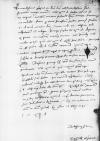List #688
Sigmund von HERBERSTEIN do Ioannes DANTISCUSKlamm, 1531-09-25
| odebrano Brussels, 1531-10-17 Rękopiśmienne podstawy źródłowe:
Pomocnicze podstawy źródłowe:
Publikacje:
| ||||||||||
Tekst + aparat krytyczny + komentarzZwykły tekstTekst + komentarzTekst + aparat krytyczny
Reverendissimo domino, domino
Reverendissime Praesul et Domine, Domine observandissime. Post servitiorum meorum commendationem.
Vestra Reverendissima Dominatio cf.
Ex
Eiusdem Vestrae Reverendissimae Dominationis deditissimus servitor
[1] A reference to the victory of Hetman Jan Tarnowski over the forces of Moldavian Hospodar Petru Rareş (see footnote 3) at Obertyn on August 22, 1531. Sigismund I informed Ferdinand I of this in a letter dated September 3, 1531 (cf. Acta Tomiciana, vol. 13, ed. by Zygmunt Celichowski, Poznań, Biblioteka Kórnicka, 1915 ⌊AT 13cf. Acta Tomiciana, vol. 13, ed. by Zygmunt Celichowski, Poznań, Biblioteka Kórnicka, 1915 ⌋, No. 307, p. 289-290). Fulfilling the wish of King Sigismund I from his letter of September 4, 1531 (delivered on September 24) that he spread the word of this victory and the reasons behind the conflict at the court of Charles V and Ferdinand I and among the dukes and estates of the Reich, Dantiscus wrote a propaganda piece in Brussels that was published in Lovanium by Rutgerus Rescius before October 21, 1531, titled: Victoria Serenissimi Poloniae Regis contra Voieuodam Moldauiae Turcae tributarium et subditum parta 22 Augusti 1531, and also in the same year in a French translation in Paris (see cf. Acta Tomiciana, vol. 13, ed. by Zygmunt Celichowski, Poznań, Biblioteka Kórnicka, 1915 ⌊AT 13cf. Acta Tomiciana, vol. 13, ed. by Zygmunt Celichowski, Poznań, Biblioteka Kórnicka, 1915 ⌋, No. 312, p. 295, No. 337, p. 317, No. 361, p. 335-336, cf. cf.
[2] Petru IV Rareş carrying out his plan to establish a great Moldavia, he followed a conflict-oriented policy that led the sultan to oust him from the hospodar’s throne in 1538. At first he was on Ferdinand I’s side, but when Suleiman I supported János I Zápolya, Rareş changed sides and in 1529, as Zápolya’s ally, defeated Ferdinand I’s forces at Földvár (Ger. Marienburg) near Braşov in Transylvania. In late November 1530, as the sultan’s vassal and allegedly with his knowledge, he invaded Pokuttya (Pol. Pokucie – a historical area between the upperPrut and Cheremosh rivers, today in Ukraine), part of the Kingdom of Poland, the outcome being his defeat in the battle of Obertyn (see footnote 1).
[3] Herberstein probably learned about the victory at Obertyn from two letters of Krzysztof Szydłowiecki, written in Cracow, even though the later one, of September 15, 1531, gives no hint as to the instigator of the invasion of Pokuttya. In his letter informing Ferdinand I of the victory at Obertyn (see footnote 1), Sigismund I implied that he knew very well who had put Rareş up to invading Pokuttya. Serious deliberation was given to this issue in Poland, and even in 1530 the most popular conclusion was that it could have been the sultan. Seweryn Boner, however, in his letter of December 22, 1530 to an unidentified official of Ferdinand I, clearly blamed János I Zápolya. The addressee of this letter was probably Herberstein, a correspondent of Boner’s. This is suggested by an expression in the letter addressing the recipient as a participant of the meeting in Poznań in 1530 (see cf.


 AAWO, AB, D. 3, f. 53v
AAWO, AB, D. 3, f. 53v